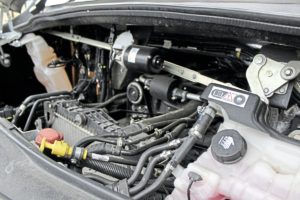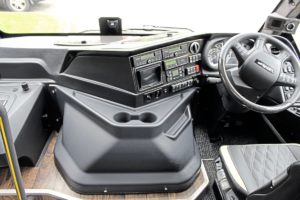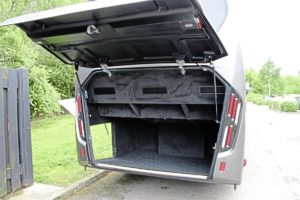Turas 900S midicoach gets DAF
Rob Orchard puts Noones new DAF-powered 900S midicoach through its paces. How does it compare to the Atego-based original?
When Irish mini and midicoach builder Brian Noone announced at the back end of 2018 that they were intending to offer the 900S midicoach on a DAF chassis, I was keen to get my hands on one. Now, thanks to Steve Peck at UK distributors Midlands Bus and Coach Sales, I have.
I have always been slightly surprised that, with the death of the Mercedes-Benz Vario, manufacturers of midicoaches all seemed to turn to the Mercedes-Benz Atego range for an alternative and did not seem to consider any other potential chassis. I suppose, because those manufacturers are mostly based in Europe, it was a natural move and of course the three-pointed star does still have a cachet.
However, I was surprised that they did not consider other chassis, particularly the DAF LF range. This range of two-axle truck chassis has earned an enviable reputation in the truck world for reliability, performance and fuel economy and the range has won a number of awards. The product is hugely popular throughout Europe.
From our point of view it also has an added bonus because it is a rarity; a chassis that is actually built here in Britain. Production takes place at the former Leyland Trucks plant at Leyland in Lancashire which is these days owned by Paccar International.
I have always been a fan of DAF-powered vehicles and rate the current DAF-powered VDL Futura and Irizar ranges as among the best coaches on the market from a driver’s point of view. This is not to infer that there is anything wrong with the Mercedes-Benz Atego; there isn’t, and it is a perfectly acceptable vehicle, but everyone likes a bit of choice…
Design
When Noones first announced its Turas 900 Vario replacement it raised a few eyebrows because Noones had opted, with Mercedes-Benz agreement, to modify the steering geometry of the chassis.
This allowed the driver to be positioned further back on the chassis and thus be more in-line with the passenger door. This is positioned behind the front axle, similar to the situation that existed with the Vario. Most other manufacturers opted to retain the standard, forward control layout of the steering with an entrance aft of the front axle or with an entrance ahead of the axle.
The problem with this latter choice is that it creates problems producing a satisfactory entrance condition. This is because of catering for the bulk of the engine which is at the front of the saloon. With the Turas 900 layout much of the engine is outside the body interior.
Although Noones have now introduced the new DAF-based version they have no intentions of stopping production of the Atego-based models. Both Turas models are produced for Noones in Turkey.
The new DAF-based version of the Turas 900S comes in two versions. There is a 33-seat-plus-courier version which uses the 10-tonne GVW version of the DAF LF chassis; and a 37-seater which uses the 12 tonnes GVW chassis.
The 33-seater uses the 4.80m wheelbase chassis which produces a vehicle that is 9.167m long, 2.4m wide and 3.195m high including the air conditioning pod. The 37-seat vehicle uses the 5.10m wheelbase chassis which produces a vehicle that is 9.59m long with similar width and height dimensions as the 33-seater.
Power in both situations is the renowned DAF Paccar PX5 4.50 litre, four cylinder, common rail, direct injection, turbocharged diesel. The engine uses a combination of EGR, DPF and SCR with AdBlue additive to achieve a Euro VI standard. In both models the engine produces 213bhp (157kW) at 2,400 rpm and maximum torque of 760Nm across a wide speed range from 1300 to 2000 rpm.
Transmission choice is either the ZF six-speed synchromesh manual or the ZF six-speed 6AS800 OD AS-Tronic automated system.
Steering is variable ratio, powered rack and pinion. Suspension at the front uses parabolic leaf springs while rear suspension is the SRB-22 full air system. Ratings are 4 tonnes at the front and 7.2 tonnes on the rear of the 33-seater or 8.5 tonnes on the 37-seat version.
Brakes use discs all round and incorporate EBS, ABS, ASR and AEBS. There is also traction control, adaptive cruise control, collision protection, lane departure warning and stability control. There is also an engine exhaust brake.
Both vehicles have a 185-litre fuel tank and a 50-litre AdBlue tank. Tanks are positioned on opposite sides of the chassis to prevent incorrect filling.
The electric system is 24-Volt system with 80 Amp alternator and two, 128 Amp/hr batteries.
Wheels and tyres are 17.5-inch steel wheels shod with 235/75R tyres. Currently there is not an alloy option but that situation should be rectified shortly.
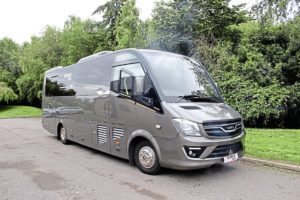 The body is constructed of welded steel tubing heavily corrosion protected and panelled. Front, rear and roof are GRP mouldings. The coach is double-glazed, with a privacy tint on all the glass. The body incorporates a nearside front entrance behind the front axle, fitted with an electric plug door. On both sides there are underfloor lockers which are illuminated.
The body is constructed of welded steel tubing heavily corrosion protected and panelled. Front, rear and roof are GRP mouldings. The coach is double-glazed, with a privacy tint on all the glass. The body incorporates a nearside front entrance behind the front axle, fitted with an electric plug door. On both sides there are underfloor lockers which are illuminated.
At the rear, a lift-up boot door reveals a large, useable space which can also be accessed through a nearside door. Capacity is 6.2m3 on the 33 seater and 6.7m3 on the 37-seater. There is also an offside rear emergency exit with automatically operated steps.
The body sides are heavily insulated with noise suppression and heat loss prevention materials and then clad in panelling incorporating soft-feel finish materials.
Interior
Throughout the saloon, the floor is wood-effect and the central aisle, cab area and entrance steps are carpeted.
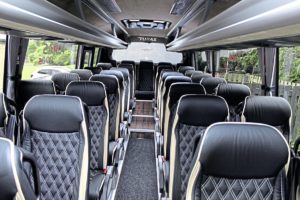 The entrance has four steps up to the central gangway area. Steps are carpeted, edge-lit and benefit from LED down lighting. Seating is mounted on raised plinths with the usual step arrangement up to the rear row of seats.
The entrance has four steps up to the central gangway area. Steps are carpeted, edge-lit and benefit from LED down lighting. Seating is mounted on raised plinths with the usual step arrangement up to the rear row of seats.
The vehicle I was evaluating was fitted with 33 Sege 360T high-backed reclining seats (except rear row) plus a courier seat alongside the entrance. Seats incorporate arm rests, three-point belts and magazine racks. They were tastefully trimmed in two-tone, quilted, leather. There are USB power points at each pair of seats.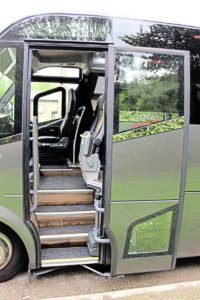
Full-length racks are fitted down both sides and have mood edge lighting and individual passenger panels incorporating reading light, fresh-air vents, sound system speakers and courier call. In the roof area there are the main saloon LED lighting with dimmable and night driving settings and two glazed, openable roof/emergency exit vents.
The saloon has full-length convection radiators down both sides of the saloon and the test example had Spheros Valeo REVO 200 22kW air conditioning from a roof-mounted system and ducted through the vehicle ceiling. A Bosch entertainment system and full-draw curtains complete the package.
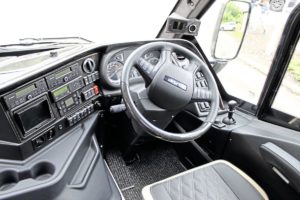 The cab is nicely laid out with a clean, clutter-free dash with well-positioned dials and controls. The driver’s seat on the vehicle I was evaluating was a Sege unit but I understand production vehicles will feature an Isri, fully-adjustable, supended unit.
The cab is nicely laid out with a clean, clutter-free dash with well-positioned dials and controls. The driver’s seat on the vehicle I was evaluating was a Sege unit but I understand production vehicles will feature an Isri, fully-adjustable, supended unit.
The driver’s side window is electrically operated and is heated. There is a large single-piece heated front screen with electrically-operated sunblinds both sides. External mirrors are electrically adjusted and heated. The vehicle has a reversing camera with dash-mounted screen.
Other cab features are cup holders, USB and mobile phone sockets, storage lockers and a dash locker which can also house a fridge unit. The comprehensive sound system incorporates individual microphones for the driver and the courier.
At the wheel
I had arranged to meet Midlands Bus and Coach Sales’ Steve Peck and the Turas 900S at Chester and to join him on his journey towards Holyhead on his way to Dublin.
First impressions always count and I instantly liked the styling of the Turas 900S. It is clean. simple and crisp and I thought the graphite grey livery really suited it. I found the entrance was comfortable to use with good step heights, depth of steps and well-positioned hand holds.
First impressions of the interior are of clean, airy and luxurious finishing – you want to travel in its inviting comfortable ambience.
I let Steve feed us out through the suburbs of the city heading for the North Wales coast road to Holyhead. This gave me a chance to experience the vehicle as a passenger. I found the seating was very comfortable with good support. Excellent vision through the large panoramic windows and a comfortable interior ambience added to the quality.
Noise levels were low and there was a complete absence of any rattles or squeaks from the interior fittings and trimming. Ride was particularly comfortable at the rear even when going around the numerous roundabouts exiting Chester. There was no shake or shimmy of the body just a feeling of complete integrity.
On the outskirts of Chester I took over. Most vehicles in this category tend to be fitted with a driver’s door because of the forward engine but because of the re-positioned steering on the Turas, Noones felt it was unnecessary. Access to the driver’s seat is therefore inevitably slightly impeded by the engine intrusion but it isn’t a problem.
I mentioned earlier that the driver’s seat on this vehicle was a Sege unit. It seemed comfortable enough and easily adjustable, but I was not keen on the left-hand location of the seatbelt and I was therefore pleased to hear that on production vehicles it will be replaced by an Isri unit.
The vehicle was very quiet at idle; quite difficult to hear the lovely note of that DAF engine. The vehicle was fitted with the ZF AS-Tronic transmission. Readers will know that I have always been a fan of the AS-Tronic. I know others don’t share that view and find its inevitable slight delay when making changes, frustrating. I first drove the AS-Tronic years ago when it was a set of bits operated for me by a chap with a laptop sitting alongside me.
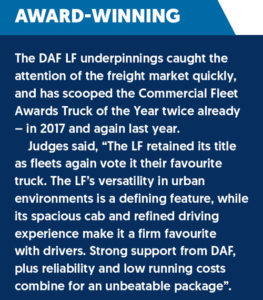 I’ve always found that if you leave it alone and let it get on with its system it will make perfect changes and you can achieve a performance very close to that of a fully automatic. Over the years ZF has consistently improved the performance of the transmission in terms of change quality and the Turas 900S demonstrated that beautifully. It made effortless smooth changes both up and down the box.
I’ve always found that if you leave it alone and let it get on with its system it will make perfect changes and you can achieve a performance very close to that of a fully automatic. Over the years ZF has consistently improved the performance of the transmission in terms of change quality and the Turas 900S demonstrated that beautifully. It made effortless smooth changes both up and down the box.
I found the driving position very comfortable with excellent vision through the large screen. Good mirror positions and good mirrors plus an absence of blind spots made manoeuvring easy.
Regular users of the coast road to Holyhead will know that it can be busy with plenty of artics heading for the port. Opportunities to really give the Turas its head were limited but it remained very docile during the waiting period, always feeling totally on top of the job.
Ride at the front was good with light positive steering. Once the road cleared, she soon picked up her feet and quickly achieved cruising speed and was happy to sustain that. Inevitably, with all the trucks, there were times one was forced to apply some retardation via the brakes or the exhaust brake. Both worked very effectively.
We have to discuss noise. As I pointed out in my road test on the Unvi Voyager GT (https://is.gd/s4VxQW), noise is very subjective and often vehicles which have the same dB noise level can appear to be different. This is because of the tone of the noise – some seem to be harsher than others and we tend to interpret that as being louder. The DAF-powered Turas is quiet… very quiet. Well at least, I think it is. Do I think it is quieter than the Mercedes-Benz Atego? Yes I do, but the differences are marginal and probably attributable to the Mercedes engine having, in my view, a harsher engine note than the DAF.
I have to say that I do prefer the AS-Tronic transmission when compared to the Power Shift3 automated transmission used by Mercedes-Benz on the Atego. Despite the fact that Mercedes has made definite improvements to the change system of the Power Shift transmission, I still do not think it is as good as the AS-Tronic.
Another factor which might be important to you is the strength and reputation of the DAF dealer network and its understanding of the needs of coach operators.
In recent times this sector of the market has seen front-engined vehicles come under attack from rear-engined alternatives. However one factor that the front engine vehicles have currently over their rear engine rivals is that they are substantially better on fuel. On our run from Chester to Bangor, where I left the vehicle, despite the sometimes heavy traffic, our average was nudging 17mpg.
I congratulate Noones on the Turas 900S it is a really nice coach. It looks quality from the outside and that feeling is carried on when you board the vehicle. By now offering it on the DAF LF base they have widened your choice.
Find DAF Trucks for Sale Find DAF LF Trucks for Sale
